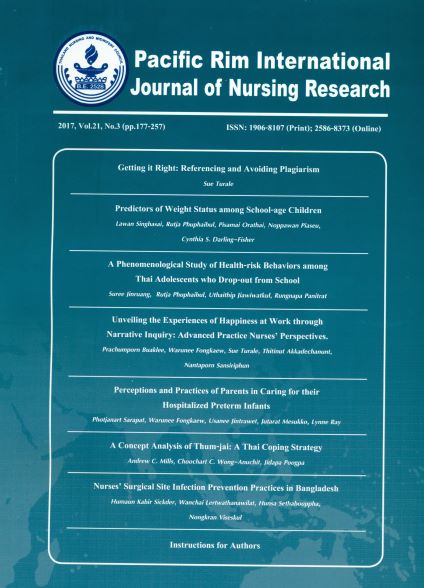A Phenomenological Study of Health-risk Behaviors among Thai Adolescents who Drop-out from School
Keywords:
adolescent school dropout, health-risk behaviors, phenomenologyAbstract
This study explored the lived experiences of adolescents residing in a slum area in Thailand who had dropped out of school. Giorgi’s phenomenological methodology was used, and data gathered through focus group discussion and semi-structured interviews with 14 participants. Data were collected from July 2011 to June 2012. This study illuminated the lived experiences of the adolescents who engaged in health-risk behaviors.
Three phenomenological themes emerged: encountering life adversity, my health-risk behaviors, and bounced back effects. The participants explained their attitudes to the factors that lead them to health risk behaviors or encountering life adversity meant living with at-risk families and being forced into premature adulthood, which were all self-reported health-risk behaviors. They indicated that they had an ability to bounce back from the problems related to these behaviors. In order to encourage and promote health among adolescents who drop out from school, nurses have to concentrate on assessment and care planning of adolescents’ risk behaviors and the determinants to these, including adolescents’ friends and families.
References
2. Hale DR, and Viner RA, Systematic review of effective interventions for reducing multiple health risk behaviors in adolescence. Am J Public Health. 2014;104(5):1-23.
3. De Winter AF, Visser L, Verhulst FC, Vollebergh WA, Reijneveld SA, Patterns and predictors of multiple health risk behaviors among adolescents: The TRAILS study. Prev MedSee comment in PubMed Commons below. 2016;84:76-82.
4. World Health Organization. Road accidents, suicide and maternal conditions are leading causes of death in young people. [cited 2009 11 October]. Available from https:// www.who.int/mediacentre/news/releases/2009/ adolescent_ mortality.
5. Kongkeaw C. Wrong doing reduction strategy in underage drinking. Bangkok: Jaransanitwong Publication.2007.
6. Ruangkanchanasetr S, Plitponkarnpim A, Hetakul P, Kongsakon R. Youth risk behavior survey Bangkok, Thailand. Journal of Adolescents Health. 2005:36:27–235.
7. Sang-arthit S, Tangkirachai S, Jetsrisupap A. Predictor of cigarette, alcohol and substance abuse among adolescents. Journal of Faculty of Nursing, KKU. 2007;30(2):12–19.
8. Hutabhaedya B, Somseub C, Patrathiti P, Siansalai S, Apiwattanalanggarn K. Alcohol consumption behaviors of Thai adolescents: a survey of knowledge, situation and factors influenced to alcohol consumption behaviors. The 44th Kasetsart University Academic Conferences Meeting. 2006:581-87.
9. Thoomtong B. Factors, cultural mechanism and enable factors that encourage to alcohol \consumption among students who study in basic education level, northeast region, Thailand. International Alcohol Review: Center of Alcohol Studies. 2008.
10. Praisri J. Factors influencing health-risk behaviors among adolescent students [Unpublished master’s thesis]. Bangkok, Thailand: Mahidol University. 2001. [In Thai].
11. Office of the Permanent Secretary Ministry of Education. The number and percent of student who drop out from school. [cited 2016 24 November]. Available from: https:// www.m-society.go.th/article_attach/18129/20176.pdf.
12. Social determinants of health and well-being among young people: Health Behavior in School-Aged Children (HBSC) study: international report from the 2009/2010. [cited 2017 January 28]; Available from: https://www.euro.who.int/__data/assets/pdf_file/0003/163857/.pdf
13. Lerner RM, Petersen AC, Silbereisen RK, & BrooksGunn J, (Eds.). The developmental science of adolescence: History through autobiography. New York: Psychology Press; c2014. Chapter 23, Problem behavior theory: A half century of research on adolescent behavior and development; 239-256.
14. Steptoe A & Wardle J, Health risk behavior: prevalence and link with disease. In Kaptein A & Weinmen J (Eds), Health Psychology. BPS: Blackwell. 2004.
15. Lynn R, and Horner SD, Youth resilience framework for reducing health-risk behaviors in adolescents. J Pediatr Nur. 2003;18(6):379-88.
16. Office of Juvenile Justice System Development, Department of Juvenile Observation and Protection: Annual report 2008: Case Statistics. [cited 2010 November 16]. Available from https://www2.djop.moj.go.th/stat/main.
17. Giorgi A, The theory, practice, and evaluation of the phenomenological method as a qualitative research procedure. J Phenomeno Psyc. 1997;28(2): 235–61.
18. Office of Municipality, Annual Report: Community data in social aspect: [cited 2012 November 10]. Available from: https://www.tmsbr.go.th/2296).
19. Keeler HJ, & Kaiser MM, An integrative model of adolescent health risk behavior. J Pediatr Nurs. 2010; 25(2): 126-137.
20. Lincoln YS, & Guba EG, Naturalistic inquiry. Newbury Park, CA: Sage. 1985.
21. Connell AM, Dishion, TJ, Yasui M, and Kavanagh K, An adaptive approach to family intervention: linking engagement in family-centered intervention to reductions in adolescent problem behavior. J Cons Clin Psych. 2007;75(4):568-79.
22. Taylor, M. J., Merritt, S. M., & Brown, C. M. Perception of family caring and its impact on peer associations and drug involment among rural dwelling. African American and White adolescnts. J Ethinic Subst Abuse. 2012;11:242-61.
23. Kumpler. K. L. Family based intervention for the prevention of substance abuse and other impulse control disorder in girl. ISRN Addiction. 2014; ID 308789.
24. Nicaise, I., Tongothai, P., Fripont, I., School dropout in Thailand: Cause and remedies. [cited 2000 November 15]; Available from https://lirias.kuleuven.be/handle/123 456789/189288.
25. Elisabetta, S. and Maria, E. D. C. Positive personality as a predictor of high resilience in adolescence. J Psych and Behav Sci. 2015;(3)2:45-53.
26. Nourian, M., Shahbolaghi., F. M., Tabrizi, K. N., Rassouli, M. and Biglarrian, A. The Lived experiences of resilience in Iranian adolescents living in residential care facilities: A hermeneutic phenomenological studu. Int J Qual Stud Health Well-being. 2016;1:30485.
Downloads
Published
How to Cite
Issue
Section
License
Copyright: The Pacific Rim International Journal of Nursing Research, Thailand Nursing & Midwifery Council has exclusive rights to publish, reproduce and distribute the manuscript and all contents therein.








.png)



